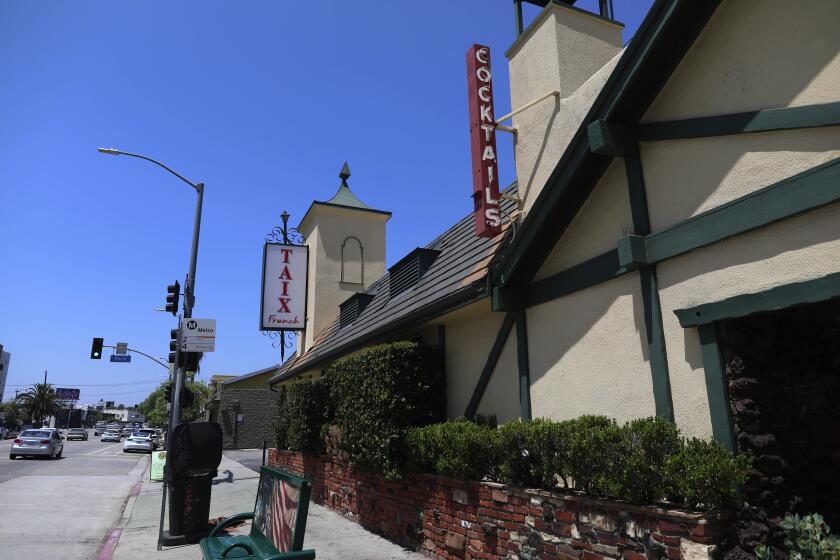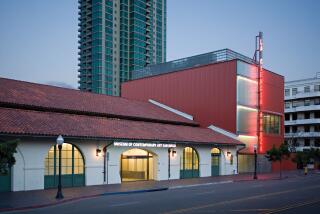Why L.A. monument status for ‘Pop Art nun’ Corita Kent’s studio matters for women in art
If you drew a Venn diagram that brought together Charles Eames, Pop Art, commercial printing, social justice movements, the Second Vatican Council and 1960s Los Angeles, only one person could inhabit the space where those areas intersect: Corita Kent.
A nun in the order of the Immaculate Heart of Mary for more than three decades, Sister Mary Corita was a well-known educator and artist dubbed the “Pop Art nun” by the press. A key mentor was Eames; she went on to mentor Sister Karen Boccalero, who founded the Chicano art center Self Help Graphics & Art in East L.A.
In her classroom at Immaculate Heart College, Kent taught the art of silkscreen printing — a commercial form that she adapted to the era of Pop. In the wake of the Second Vatican Council in 1962, which called for a liberalization and modernization of the Catholic liturgy to the realities of 20th century life, she delved into creating work that echoed calls for social justice — be it antiwar efforts, labor campaigns or Black and Chicano civil rights.
Her work at its most innovative took vernacular culture — commercial logos and graphics, bits of corporate slogans, images from mass media — and reconfigured them into fine art. Art that not only advanced the ways in which these elements were used formally, but that grounded Pop, a form that could be too enamored of its own cleverness, in currents that were as spiritual as they were political.
As independent curator Michael Duncan wrote of her work in a 2013 catalog: “She addressed consumers not of products but of life.”
Pope Francis, meet Sister Corita.
(That catalog, incidentally, was published in connection with the engaging Kent retrospective “Someday Is Now: The Art of Corita Kent,” at the Pasadena Museum of California Art in 2015.)
Almost 35 years after her death, Kent is still breaking new ground. On Wednesday, the L.A. City Council approved historic-cultural monument status for the artist’s former studio — a humble storefront on Franklin Avenue, near Western Avenue that in recent years had been inhabited by a dry cleaner.
The designation is important not just because Kent was an artist whose work was a critical part of the artistic dialogues Los Angeles was having in the 1960s, but also because she represents the rare woman to be honored in the city’s landscape.
As the Los Angeles Conservancy noted in its advocacy for preserving Kent’s studio building, only 3% of the city’s more than 1,200 historic-cultural monuments are associated with women’s heritage. (And as my colleague Makeda Easter reported in April, only 6% are associated with communities of color.)
In fact, L.A. generally has relatively few historic-cultural monument sites associated with visual arts history. Among them are the Tom of Finland House in Echo Park, the Santa Monica residence and studio that once belonged to artist Don Bachardy and writer Christopher Isherwood, and the rambling hillside estate that is the former site of the Hollywood Art Center School, the independent art school established by Henry Lovins in the early 20th century.
The Getty Conservation Institute and the city are embarking on a three-year project to preserve landmarks that represent Black heritage across L.A.
There are fewer sites associated exclusively with women artists. A cursory scan of the lengthy historical-cultural monuments list produced by the Department of City Planning turns up the Woman’s Building in Chinatown, which had served as a hub of feminist art production in the 1970s and ‘80s.
Even at a national level it’s hard to find studios that belonged exclusively to women. Painter Georgia O’Keeffe’s former home and studio in New Mexico is one of the rarities. Historic studio spaces that do incorporate women tend do so as part of a pair, such as the home that once belonged to Abstract Expressionist painters Lee Krasner and Jackson Pollock on New York’s Long Island or the Charles and Ray Eames House in L.A.’s Pacific Palisades.
The designation is reflective of a shift in preservationists’ thinking about how we acknowledge history — thinking that is less preoccupied with the pristine historical details of a site than in making sure a wide range of histories are acknowledged in a city’s landscape. Late last year, the 1970 protest route of the Chicano Moratorium was listed in the National Register of Historic Places; early this year, the Church of the Epiphany in Lincoln Heights — a key site of Chicano activism — was added to the list.
In April, the Getty Conservation Institute announced it was teaming up with the Office of Historic Resources at the Department of Planning to help identify and preserve sites connected with Black heritage. The Getty’s Susan Macdonald told The Times that this was a moment to reevaluate how sites are deemed historic and examine the “processes and practices” that might serve as “barriers to social justice.”
The storefront that Kent inhabited, where she taught and collaborated with students and created some of her most memorable work, no longer bears traces of her presence.
Kent left the space — and Los Angeles — after she withdrew from the Immaculate Heart of Mary order in favor of a secular life in the late 1960s. Part of her departure may have been due to pressures related to her increasingly high profile: At one point, she was featured on the cover of Newsweek. It may have also stemmed from simmering tensions between the liberal Immaculate Heart order and the staunchly conservative Archbishop James Francis McIntyre, who once complained that that the work produced by Kent and the college’s art department was “an affront to me and a scandal to the archdiocese.” In 1970, Immaculate Heart split from the church and is today an independent ecumenical community.
The studio storefront, which is currently unoccupied, sits on a small corner of a 1.7-acre parcel that also contains a shuttered Rite-Aid. Recently, the plot was acquired by a pair of real estate development companies who intend to turn the site into a Lazy Acres natural foods market. Part of their original plan had been to tear down the studio to make way for additional parking. (Yes, parking.) That plan has since been amended to leave the old studio building intact.
This comes thanks to the work of many L.A. preservationists, among them the staff at the Corita Art Center, which is located just across the street in a complex of buildings still inhabited by the Immaculate Heart Community.
“The big question is what’s next,” says the center’s director Nellie Scott. It’s too soon to say what the developers will do with the property — whether they would sell it or lease it for the purpose of an arts center. “We know that there are a thousand more conversations to happen.”
Scott hopes that the end result is something that is in keeping with Kent’s spirit — which wasn’t simply about showing off polished works, but instead more focused on spurring collaboration and thinking around social action.
“It’ll be a shared vision with our neighbors, and the larger community as well, as how do we center artistic process and community,” she says. “The finished product on the wall is great. The art is what we center around. But the process is what we are interested in. So how do we center that?”
A developer’s plan has set off a debate over whether L.A. should try to protect the building that has long been home to Taix, a popular Echo Park restaurant.
The location couldn’t be better for something of that nature: It’s one block from a Metro stop and there is a high school right across the street. (And for those who a like a bit of the unholy, it’s also right around the corner from Charles Bukowski’s favorite Hollywood liquor store, the Pink Elephant.)
Plus, there is something poetic about being able to catch a bit of art on a trip to the grocery.
“It’s how do you incorporate art into the everyday,” says Scott. “That was at the core of Corita.”
Art preoccupied with the spiritual and the political? In an easily accessible place that isn’t dominated by the art market? We could all use a bit more of that.
More to Read
The biggest entertainment stories
Get our big stories about Hollywood, film, television, music, arts, culture and more right in your inbox as soon as they publish.
You may occasionally receive promotional content from the Los Angeles Times.












